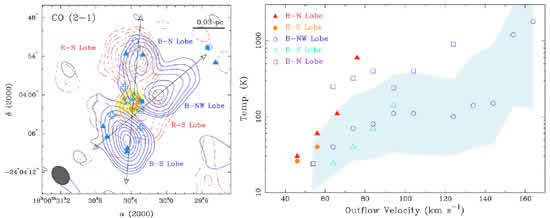Research Gallery > Star Formation Studies
Research Gallery
Star Formation Studies
| The Extremely High-Velocity Outflow from the Luminous Young Stellar Object G5.89-0.39 |
|
Image Credit: Su et al.

Left: Extremely high-velocity molecular outflows of G5.89-0.39 in CO (2-1) imaged with the SMA. Right: The outflowing gas temperature versus the gas velocity deduced from the LVG calculations. An increasing trend of the gas temperature with the outflow velocity can be discerned toward all lobes.
|
| Although molecular outflows have been commonly identified around both low- and high-mass young stellar objects, it is not clear how the bulk of the outflowing gas is accelerated. Exploring the physical conditions of the extremely high-velocity outflowing gas in details will be helpful for clarifying its role in
star formation processes. The massive star forming region G5.89-0.39 is associated with energetic CO outflows with velocities up to ~70km s-1 from its systemic velocity, the highest gas velocities that have been detected in molecular outflows. With the SMA observations in CO (2-1) and (3-2), we have for the first time estimated the temperature of the outflowing gas as a function of the velocity. Our results reveal a clear increasing trend of the temperature with the gas velocity. The observational features of the extremely high-velocity gas associated with G5.89-0.39 qualitatively favor the jet-driven bow shock model. (Su et al., 2011, submitted) |
 asiaa.sinica.edu.tw Media Request: epo
asiaa.sinica.edu.tw Media Request: epo asiaa.sinica.edu.tw
asiaa.sinica.edu.tw 
